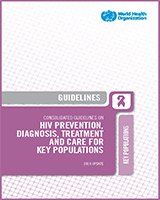| Jamaica | Andrinopoulos K, et al (2010) | Demonstration project provided mandatory opt-out testing for new prisoners and psychiatric patients and voluntary HIV testing for prisoners >6months. Pre/post-test counselling provided. 63% accepted voluntary testing and 16% refused mandatory opt-out testing. Relatively high rate of acceptance for voluntary testing. Confidentiality was assured and HIV education was provided. |
| USA | Arp W (2009) | Prisoners were surveyed and asked if they believe inmates should be tested for HIV when they enter prison and when released from prison. Among surveyed inmates, 97% agreed inmates should be given a mandatory test for HIV and 99.7% agreed every inmate should receive treatment for HIV/AIDS when they have tested positive. |
| USA | Kavasery R, et al (2009) | Male prisoners accepted HIV testing at higher rates when opt-out testing was offered within 24 hours of incarceration. |
| USA | Kavasery R, et al (2009) | Female prisoners accepted testing in prison at higher rates when opt-out testing was presented immediately (within 24 hours) after incarceration. Prison staff stated they preferred to offer testing immediately because of high turnover rates. |
| USA | Duffus WA, et al (2009) | Retrospective cohort study demonstrated the lack of routine HIV screening in South Carolina correctional facilities fostered missed opportunities for earlier diagnosis of HIV for inmates. Routine screening and testing should be implemented in prisons to facilitate early diagnosis of HIV. |
| USA | Jafa K, et al (2009) | HIV diagnosis was delayed among prison inmates because of a lack of testing in prison facilities. The importance of timely diagnosis and appropriate treatment is demonstrated by the high proportion of seroconverters who were infected with drug-resistant strains. |
| USA | Javanbakht M, et al (2007) | Prevention programmes existing in the MSM unit include individual level HIV education and prevention, condom distribution, and HIV and STI counselling. Screening resulted in a high prevalence of STIs and HIV. |
| USA | Beckwith CG, et al (2010) | Only 28% of participants in conventional cohort received HIV test results versus 100% in rapid test cohort. Rapid testing greatly improved the odds of receiving test results. |
| USA | Macgowan R, et al (2009) | Rapid testing was able to identify a considerable number or previously undiagnosed cases of HIV infection and greatly improved the number of prisoners receiving their results and the time in which results were delivered. |
| South Africa | Motshabi LC, et al (2011) | Majority of participants were knowledgeable about HIV transmission, however, barriers to preventing testing and counselling include: stigma, discrimination, lack of trust in health care professionals, poor or bad attitudes of health care professionals, and not knowing about availability of VCT. Programmes addressing stigma and discrimination among health care workers should be implemented. |
| USA | De Voux A, et al (2012) | Results from the EnhanceLink demonstration project suggest that HIV testing in jails can lead to new diagnoses of HIV infection and that these infections are being diagnosed substantially early on in the course of the disease. Rapid turnover was not found to be an impediment to jail-based HIV screening. Most inmates did not initiate care while detained. Linkage to care after release emphasized. |
| USA | Beckwith CG, et al (2011) | Staff and key informants interviewed about rapid HIV testing experience. Positive experiences were reported with rapid testing and the method was preferred over conventional testing models. Prisoners were reported to be more compliant when offered rapid testing versus conventional testing and staff workload was reduced. Universal agreement that immediate access to HIV test results is an advantage and benefit of rapid testing, especially with high turnover of prisoners. |
| USA | Strick LB, et al (2011) | Change in procedure from testing request to opt-in testing to opt-out testing in Washington State Jails increased testing among inmates from 5% to 72% to 90%, respectively. Opt-out testing was most effective at case detection. |
| USA | Tartaro C, et al (2012) | As part of the testing process, inmates are assured they will receive free medical care during duration of jail stay and those that lack health insurance will receive outpatient treatment from a local service provider upon release. Rapid testing increases the number of inmates receiving test result before discharge. A large percentage of prisoners received their first HIV test in jail. |
| USA | Tuli K, et al (2009) | HIV and syphilis screening and condom distribution programmes were initiated in the MSM unit of the Los Angeles county jail. Modeling indicates that the intervention can avert many sexually transmitted infections at low cost and can save costs in a scenario in which inmates continue to engage in sexual activity as they do outside jail. |
| Multiple | UNODC, UNAIDS, WHO (2009) | Review document on HIV testing and counseling in prisons. Evidence and current practices reviewed, minimum requirements for programs are given, and policy framework and recommendations included in the document. Prisons should introduce comprehensive HIV prevention programs that include: information and education, provision of condoms and water-based lubricant, needle and syringe programmes, other measures to decrease sexual transmission, drug dependence treatment, and HIV treatment, care, and support, including provision of ART. |
